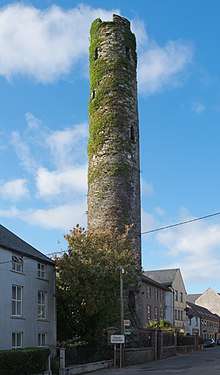Cloyne Round Tower
Cloyne Round Tower is a round tower in the historically monastic town of Cloyne, County Cork in Ireland. Cloyne was also the "see city" of the Anglican (Church of Ireland) Diocese of Cork, Cloyne and Ross. The tower is a symbol for the town of Cloyne.
| Cloyne Round Tower | |
|---|---|
Cluain | |
 Round tower at Cloyne | |
| Religion | |
| Affiliation | Pre-Reformation Catholic |
| Location | |
| Location | Church Street, Cloyne, County Cork, Ireland |
 Shown within Ireland | |
| Geographic coordinates | 51°51′43″N 8°7′13″W |
| Architecture | |
| Style | Irish round tower |
| Groundbreaking | 10th century |
| Specifications | |
| Height (max) | 30.5 m (100 ft) |
| Materials | sandstone |
History
The monastic settlement at Cloyne dates to about 560 AD, when Saint Colman mac Lenene (who died in 604) founded the original monastery. The round tower itself dates to around the 10th century, and is approximately 30m high and 16.25m around when measured about 1.5m above the ground. The stone in the tower is dark purple sandstone.[1][2][3] As with some other round towers, a lightning strike caused some damage to the top of the tower. The strike was in 1749.[4] There is also the ruin of a Norman watchtower on a hill overlooking the town.[5]
The town has a cathedral from its time as a religious centre, as well as a more recent church. The Church of Ireland Cathedral dates to 1250 A.D.[6] The local Catholic church, St. Colmans, was built in 1815.[7] The round tower was used to hang the Cathedral bell in the 19th century.[8][9]
.jpg)
Further reading
- Thomas Bell (1829). An Essay on the Origin and Progress of Gothic Architecture: With Reference to the Ancient History and Present State of the Remains of Such Architecture in Ireland. William Frederick Wakeman. p. 92.
- George Petrie (1845). The Ecclesiastical Architecture of Ireland Anterior to the Anglo-Norman Invasion: Comprising an Essay on the Origin and Uses of the Round Towers of Ireland ... Hodges and Smith.
- Cork City Library - Cork Past and Present project - Including images of the tower
References
- "Cloyne Irish Round Tower". Roundtowers.org. Retrieved October 23, 2016.
- "Cloyne Round Tower, County Cork". Megalithicireland.com. Retrieved October 23, 2016.
- "Cloyne Round Tower". Discoverireland.ie. Retrieved October 23, 2016.
- "Cloyne Round Tower Co. Cork". roundtowers.org. Retrieved 21 June 2013.
- "Castle Hill, Cloyne". gatecottages.wordpress.com. Retrieved 24 Nov 2013.
- "Cloyne Union Information". cathedral.cloyne.anglican.org. Archived from the original on 3 September 2014. Retrieved 1 September 2014.
- "Parish-details Cloyne". cloynediocese.ie. Archived from the original on 15 April 2014. Retrieved 14 April 2014.
- "Cloyne Round Tower". Irishantiquities.bravehost.com. Retrieved October 23, 2016.
- Colum Hourihane (2001). From Ireland Coming: Irish Art from the Early Christian to the Late Gothic Period and Its European Context. Princeton University Press. pp. 43–. ISBN 0-691-08825-X.